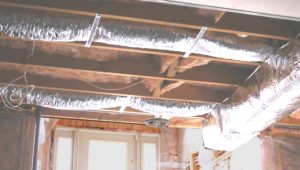Flex duct versus metallic duct: for decades many considered duct material the key to how well an HVAC system delivers airflow to the conditioned space. You should start paying closer attention to this discussion. Events unfolding over the next few months could ultimately determine how much flexible duct you will be allowed to use when installing duct systems.
A recent proposal from the International Association of Plumbing and Mechanical Officials (IAPMO) limits the use of flexible duct to only 5 feet in length. While this proposal is still under public review, if passed it could go into the 2018 Uniform Mechanical Code for immediate enforcement.
How Did We Get Here?
Unfortunately, poor quality flex duct installations across the country are coming home to roost. Opponents know the common problems with flex duct installations and are displaying them for all to see.
Instead of focusing on correctly installing flexible duct as intended by the manufacturers, we have reduced it to a way of installing a duct system in record speeds. We took our eye off craftsmanship and replaced it with haste. In the eyes of many, this approach has cost us dearly with this duct material. The entire industry will pay a price unless the proposal is overturned.

Flex duct lengths could be dictated by proposed legislation. Do you want the government limiting your ability to solve customer problems?
The Root Cause
HVAC contractors who measure airflow know there’s more to consider than duct material on proper airflow through an HVAC system. The issue here is a duct sizing and installation problem, not a duct material problem.
There are flexible duct installation standards that spell out how to install flexible duct the right way. Every box of flex I’ve opened has a two-sided sheet that includes recommended installation instructions. Most end up in the trash or burn pile.
By paying attention to detail, you can solve the top five problems with flexible duct installations. They are:
- Sagging due to inadequate suspension and excess duct material
- Kinked duct due to sharp bends and improper hanging materials
- The inner core bunches up because it isn’t pulled tight and cut to length
- The ducts are not correctly fastened to takeoffs and boots
- Flexible duct is sized using methods intended for sheet metal duct
Superior Flex Duct Performance
This proposed change fails to recognize how flexible duct outperforms metal ducts in certain areas. Flexible duct is superior when it comes to its thermal insulation and sound attenuation characteristics. Flexible duct also assures lower duct leakage compared to most metal duct installations.
Another consideration: installation costs. In areas of the country where residential and light commercial HVAC systems typically use flex duct, the cost of requiring primarily metal duct systems will increase the cost of the duct system from 40% to 110%. Share that piece of information with builders and your customers. See how quickly they buy into this proposed change.
There are many valid reasons the market needs flexible duct systems. But this proposal doesn’t consider them.
Does duct system performance need to improve? Sure it does, but not by a silver bullet solution forced on our industry in the name of code compliance.
Moving Beyond Duct Materials
In the laboratory, data may suggest metal ducts perform better than flexible ducts. The same data also proves properly sized and installed flexible duct can perform equally well.
The true test is to measure delivered airflow in the field after installing the HVAC system. Have we become so confident in duct design, tightness, and material selection that we forget about really testing the system to assure it’s operating as intended?

To really solve this problem, airflow measurement has to be part of any corrective action. Design and installation intent is only verified by airflow and pressure measurement during system operation. We have to move beyond blaming duct materials for poor performance and address real issues.
What Can You Do?
If you’re guilty of sloppy, poorly performing flexible duct installations, stop doing it. Have the courage to install your duct systems the way the manufacturers intend and your customers deserve. If we don’t improve, other legislative groups and associations will continue to look at reducing the use of flexible ducts.
IAPMO has invited public comment on the flexible duct length proposal until January 3, 2017. Submit your opinions about metal and flex duct by following this link: http://codes.iapmo.org/form_comments_upc_umc_2018.aspx.
If you don’t speak up and voice your concerns on this, those who have never installed a duct system will dictate how you do it.
David Richardson serves the HVAC industry as a Curriculum Developer and Trainer at the National Comfort Institute (NCI). NCI specializes in training focused on improving, measuring, and verifying HVAC and Building Performance.
As an HVAC contractor or technician wanting to learn more about measuring airflow, contact David at davidr@ncihvac.com or call him at 800-633-7058. NCI’s website, www.nationalcomfortinstitute.com, is full of free technical articles and downloads to help you improve your professionalism and strengthen your company.


